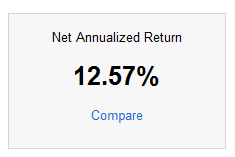As I mentioned before, I’ve been taking the normal 10% contribution amount that most would be putting into their retirement accounts and splitting it between my lending club account, and a sharebuilder account. It’s been a bit of an experiment. I happen to think that lending club is a relatively safe investment option for a portion of your portfolio. I’ve still got my 401(k) from my old job, so the investments that I’ve made at lending club and in the sharebuilder account don’t even really make up 5% of my total investments. In short, I can afford to get a bit risky with the money. So far, it’s been anything but risky, however. I’ll update on the sharebuilder account in another post. Let’s take a look at what my lending club account has done.
To date, my investments look a little like this:
- Total loans invested in: 24
- Total loans paid off:5
- Total loans defaulted: 0
 With only 24 loans, it could be that I’ve just been lucky thus far. I’ve had a couple of the loans go past due by 10-15 days, but nothing that hasn’t been caught up and made current. And no defaults. As I continue, I expect that I’ll see one or two. With all the doom and gloom about the economy recently, I fully expected to see one already.
With only 24 loans, it could be that I’ve just been lucky thus far. I’ve had a couple of the loans go past due by 10-15 days, but nothing that hasn’t been caught up and made current. And no defaults. As I continue, I expect that I’ll see one or two. With all the doom and gloom about the economy recently, I fully expected to see one already.
To date, I’ve deposited $257.20 into the account. That includes money from before this experiment started, so it’s not all recent. With that 257.20, I’ve invested in $511.36 in loans. The math savvy of you will notice that the invested amount is quite a bit more than the deposited amount. That just means that the money has turned over almost 100% since being invested. The more recent money, which accounts for about 50% of the account hasn’t had a chance to turn over yet, or that number might be higher. My total income, minus fees, is $36.26.
My portfolio breaks down like this:
- 39% of the loans are D grade
- 25% of the loans are B grade
- 15% of the loans are C grade
- 9% of the loans are F grade
- 7% of the loans are E grade
- 4% of the loans are A grade
As you can see, I’ve gone a bit riskier and weighted the portfolio towards the higher grades, but is still heavily centered around the C/C+ grade. (Read this to see how I select loans)That keeps my return a bit higher, while also keeping the risk a bit lower. Speaking of return, what is mine?
According to lending club, my net annualized return is 12.82%.
I like that. It’s far better than any bank or credit union is going to pay me for my money. To get that, I give up the liquidity of the money (I’d have to sell my notes to get the cash), and I give up some of the stability of the money (it’s riskier than a savings account or CD). Because this isn’t my emergency fund, or normal savings, I’m ok with giving up both of those things, in exchange for an above average return.
Do you invest with peer-to-peer lending? Do you use Prosper? Lending Club? Both? How’s your return?

I started this blog to share what I know and what I was learning about personal finance. Along the way I’ve met and found many blogging friends. Please feel free to connect with me on the Beating Broke accounts: Twitter and Facebook.
You can also connect with me personally at Novelnaut, Thatedeguy, Shane Ede, and my personal Twitter.

I’ve definitely been interested in doing this (in 7 months when I’m debt-free minus house). Every post I see on this shows happy users and good returns. Thanks for sharing.
BB, Congrats on your continued success at Lending Club. But I would be careful to read too much into your returns simply because 24 is a small sample size. You may be lucky or you may be a very astute loan picker.
@John I think it’s worth a try, even if you’re just dabbling with some “fun” money like I am.
@Peter Absolutely. I’d love to think that I’m an astute loan picker, but I’m sure that isn’t the only reason that I’m doing well. My loan picking process is linked above in the article, but it’s not foolproof. I fully expect to start seeing some defaults as my portfolio grows, which will certainly drop the return number. But, for now, I’m just going to enjoy it while it lasts.
Super jealous! They don’t do the lending club stuff here in AZ. If they ever open it up to Arizona I’m totally in.
How much time per month do you typically spend on this investment – doing the research, checking the loans and whatever else you have to do?
@Marie I spend very little time on this. Maybe 15 or so minutes a month. I generally wait until I have about $20 in cash there (about 2X a month) and then go and invest it. Because of the way I have to invest, that really takes about 5 minutes or so each time.
@Ashley Technically, they don’t do the lending club stuff here in ND either. But, I was able to sign up for an account, and am able to invest in loans through their trading platform. It limits, severely, the selection, and ability to do research, but otherwise, it seems to be working. Maybe you can talk to someone over there and see if you can’t get a similar set up?
My lending club investment returns are in the negative territory. I think I just had bad timing. Even the people ranked as A were defaulting. This has turned me off to micro lending in entirety. Great job on picking good investments. I’m jealous
I was an early investor in Prosper, and I got my butt handed to me back then. Looks like the P2P group has shaken out some of the kinks.
(BTW, you quote a D percentage twice in your portfolio. You have mostly higher-risk loans then?)
I’ve never tried anything like this before, but it sounds awesome. I’ll definitely put it on my ‘check it out’ list. Thanks for sharing. 🙂
@mbhunter I was an early investor in Prosper as well. And, like you, I got my butt handed to me. I think the big difference has been in the SEC procedures that both Lending Club and Prosper have had to go through. Lending Club was never not through that process, and Prosper, pre-SEC process, was a bit like the wild west of p2p lending. As for the two Ds in the portfolio, that second one should have been an E. Which, obviously, is higher risk than the D loans. When you weight it out, the portfolio as a whole ends up in the C range, so slightly higher risk, but still not all bad. Keep in mind that they don’t accept most of the prospective borrowers. I think you’ve got to have a credit score of 640 or higher to even start that process, so a C score correlates to about a 700 score. That’s somewhere around B paper at most traditional lenders, I think.
I think it’s a bit naive to have this under the category “passive income”. Unless one is using the “automated” plans, p2p investments are not “passive income”. It may not be apparent to someone with 24 notes, but I guarantee you that unless you don’t care about performance & don’t care about idle cash………… it will be apparent once you get to a portfolio in the mid to high hundreds.
@Dan B , Dan, I think your definition of “passive income” and mine differ. Take a look at my post on “What is Passive Income“, to clarify what my definition of it is. In my opinion, anyone who honestly thinks that you can have a source of income that doesn’t require some sort of maintenance is going to find themselves on the short end of a rude awakening. To me, having to check my account a couple of times a month, and spend a half hour making sure there isn’t much idle cash is “passive”.
Perhaps our definitions do differ. But if p2p is passive then what is a CD or a bond or a mutual fund? Comatose investing? 🙂
I reiterate that the “couple of times a month & a half an hour” type comments do not apply to portfolios in the mid to high hundreds. And frankly, if you’re talking about perpetually small sized p2p portfoilos, then I’d be curious if that’s an investment at all…………..& not just play money or some other term.
@ Dan B , A CD, Bond, or Mutual Fund still requires some maintenance. Unless you want to fully automate it and have it automatically roll over into a new CD, Bond, or let the fund manager do his/her thing. The problem with that is that CDs aren’t paying much of anything for interest. Not even enough to keep up with a cost of living increase each year. Bonds pay better, and there’s less maintenance, but I don’t know if you can have them automatically roll over except in a fund of some sort, and then you get expenses incurred. As for whether a portfolio on a P2P that’s in the mid to high hundreds could be maintained by visiting a couple of times a month and in a half an hour, I think it could. Yes, you’d have some cash sitting around between maintenance, so you’d lose any potential interest on that money during that period. But, how long would it have to sit idle to underperform the 1% CD you’d rather put it in? The way that I select investments, I could easily invest in several at a time, and still get hundreds of dollars invested in a half hour or less. Finally, I would agree that a perpetually small sized portfolio would be more of a play money account. At the moment, I think there’s an argument that my account fits in that category, but only based on it’s size, not on the seriousness with which I take it. I have intentions of growing the account to a size where I can test your theory of time cost in maintenance. Perhaps we’ll revisit then. 😉
Among other things I was going to point out the ridiculously obvious fact that prevailing interest rates have nothing to do with whether an investment is passive or not…………But after reading the rest of your post it’s become clear that you’re just having some fun with me. Because I refuse to acknowledge the possibility that you could be seriously arguing the points you’re arguing.
P2P lending has been a great experience for me also. Although I do not belong to US, I prefer lending on a UK based social lending platform: YES-secure.com. The lenders and borrowers maintain a good relation here. Being a new user of this platform, I enjoyed the social networking experience on YES-secure.
@Dan, Of course, interest rates have nothing to do with whether an investment is passive or not. But, here’s the thing. For a passive investment like a CD or Bond to really do me any good, I’d have to have millions in the bank. I don’t. So, I choose to use an investment that is more like 85-90% passive that offers some real income. Is it riskier? Yes. Is it less passive? Yes. But, my argument isn’t necessarily that one is better, or more passive, than another. It’s that I don’t believe that there is any 100% passive investment. Each has a variable degree of passivity. Working a 9-5, trading hours for money, is about a 5% passive investment. A CD, on the other hand, is closer to 98% or so, but you’ve still got to make the money to invest, set the CD up, and do some minimal maintenance once in a while to keep it going.
I’m not “just having fun with” you. I am seriously arguing the points. I’m not convinced that I’m wrong, and I like a good civil point-counterpoint sort of argument. 😉
BB,
You might find my website of interest. I have a lot of tools geared towards Lending Club investors. I would be curious to see you post the results of my portfolio analyzer on your blog. It provides a great deal of insight and would help your readers understand the makeup of your note selection in great detail.
The most important metric to compliment your returns is the age of your portfolio. Young notes always have high returns, as they age, cumulative defaults goes up and ROI drops.
Another consideration is cash drag. You are not making enough in repayments reinvest idle cash effectively. A portfolio needs to be in excess of 15-20K to hit a point where you can clear out idle cash every 2-4 days.
http://www.nickelsteamroller.com
@michael, It is. I’ll take a look at it. My portfolio is rather young, with the oldest note being about 2 yrs. I’m not entirely sure I know what you mean by “cash drag”. I think you mean the “slowing” of the returns by the idle cash sitting in the account while it builds to enough to reinvest. If that’s the case, then I completely agree. Currently, with my additions throughout the month, I’m averaging a new note every 3-3.5 weeks. Efficient? No. But, the more often I have to check it and reinvest, the more “active” the income stream becomes, so I’m not sure that I’ll get that technical to want to go in every few days to reinvest. I could see me doing it every week or two, though.
Yup, that’s exactly what I mean by cash drag. I think P2P is still considerably less time and stress than picking stocks. For the returns vs time put in, it’s quite an interesting investment. If you are looking for total auto pilot you should look into dollar cost averaging with betterment.com
@Michael , Yeah, it’s way less time than picking stocks. Especially for me, as I’m in a state where the only option I have is the foliofn platform. Total auto-pilot isn’t necessarily what I’m looking for, but a nice balance between good returns and minimal time required.
I’ve recently added a new feature to the NSR platform that allows you search the secondary market with ease.
http://www.nickelsteamroller.com/lendingclub_market
My I feel bad for people restricted to Folio, so hopefully this will help.